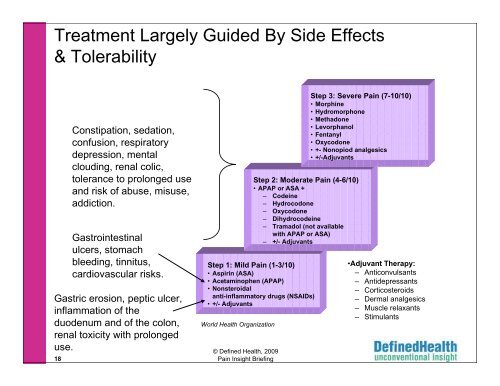Download the presentation here: PDF
Download the presentation here: PDF
Download the presentation here: PDF
Create successful ePaper yourself
Turn your PDF publications into a flip-book with our unique Google optimized e-Paper software.
Treatment Largely Guided By Side Effects<br />
& Tolerability<br />
18<br />
Constipation, sedation,<br />
confusion, respiratory<br />
depression, mental<br />
clouding, renal colic,<br />
tolerance to prolonged use<br />
and risk of abuse, misuse,<br />
addiction.<br />
Gastrointestinal<br />
ulcers, stomach<br />
bleeding, tinnitus,<br />
cardiovascular risks.<br />
Gastric erosion, peptic ulcer,<br />
inflammation of <strong>the</strong><br />
duodenum and of <strong>the</strong> colon,<br />
renal toxicity with prolonged<br />
use.<br />
Step 1: Mild Pain (1-3/10)<br />
• Aspirin (ASA)<br />
• Acetaminophen (APAP)<br />
• Nonsteroidal<br />
anti-inflammatory drugs (NSAIDs)<br />
• +/- Adjuvants<br />
World Health Organization<br />
© Defined Health, 2009<br />
Pain Insight Briefing<br />
Step 2: Moderate Pain (4-6/10)<br />
• APAP or ASA +<br />
– Codeine<br />
– Hydrocodone<br />
– Oxycodone<br />
– Dihydrocodeine<br />
– Tramadol (not available<br />
with APAP or ASA)<br />
– +/- Adjuvants<br />
Step 3: Severe Pain (7-10/10)<br />
• Morphine<br />
• Hydromorphone<br />
• Methadone<br />
• Levorphanol<br />
• Fentanyl<br />
• Oxycodone<br />
• +- Nonopiod analgesics<br />
• +/-Adjuvants<br />
•Adjuvant Therapy:<br />
– Anticonvulsants<br />
– Antidepressants<br />
– Corticosteroids<br />
– Dermal analgesics<br />
– Muscle relaxants<br />
– Stimulants



